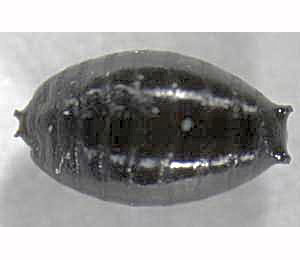|
||||||
|
CARUM. Caraways. [Apiaceae] |
|
Two species of Carum are recorded in Britain, the native Whorled Caraway (C. verticillata) and the introduced Caraway (C. carvi). Three British miners are recorded on Carum. A key to the European miners recorded on Carum is provided in Bladmineerders van Europa. |
|
Key for the identification of the known mines of British |
1a > Leaf-miner: In the first instar the larva mines the leaves, forming short, irregular, blotch-like mines, but in later instars it lives externally, feeding in spun leaves and often twisting those of tender shoots. Larval head light-brown or yellowish brown, edged with black postero-laterally, ocellar area blackish; prothoracic plate black edged with whitish anteriorly; abdomen dull dark green; pinacula distinct, black, sometimes brownish but with black bases to setae; anal plate large, black (Bradley et al., 1973). Small, full depth mine without a definite shape; little frass. Some silk is deposited in the mine. The larva soon leaves the mine and continues feeding among spun leaves. |
|
Cnephasia incertana (Treitschke, 1835) [Lepidoptera: Tortricidae]. |
1b > Leaf-miner: The larvae are often gregarious and feed on the underside of the leaf causing a 'windowing' effect as they eat the mesophyll and lower epidermis. This effect can be seen from the top of the leaf as it discolours. Short, small, irregular, sometimes widened corridor. Mostly a number in a leaf, concentrated in the axils of the midrib and the primary side veins. Each larva makes a number of mines. Often the larva protrudes with its rear end out of the mine, causing most frass to be ejected. While moving, at the leaf underside, silken threads are produced, in wich grains of frass may be trapped. Older larvae live free and cause window feeding, often in a group under a light spinning. |
|
Epermenia chaerophyllella (Goeze, 1783) [Lepidoptera: Epermeniidae]. |
1b > Leaf-miner: A short, narrow, linear mine, generally closely following margin of leaf segment; in very small sections of a leaf producing a secondary blotch (Spencer, 1972b: 89 (fig. 302), 92; Spencer, 1976: 401 (fig. 702), 402). Upper-surface corridor, in the end widening so strongly that within the limited space of an umbelliferous leaf often a secondary blotch is the result. The upper-surface mine is preceded by a short lower-surface corridor, made by the first instar larva during the first part of this stage (Allen, 1956a). It is difficult to observe, also because it tends to follow the leaf margin. Frass in two untidy rows of isolated grains. Before pupation the larva leaves the mine through a semicircular exit slit in the lower epidermis. A narrow mine, follows leaf marginand forms secondary blotches. |
 Phytomyza chaerophylli puparium Image: © Willem Ellis (Bladmineerders van Europa) |
|
Phytomyza chaerophylli Kaltenbach, 1856 [Diptera: Agromyzidae]. |
| Last updated 01-Jul-2019 Brian Pitkin | ||
